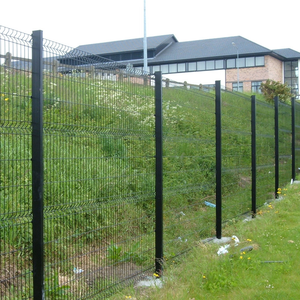(23127 products available)










































































































































































































Safety wire fencing is essential for livestock and other animals. This is because it provides an additional measure of security against unwanted intruders.
In addition, safety wire fence serves multiple purposes. Some of its basic uses include protecting crops from damage, forming physical boundaries, and defining land ownership.
They offer numerous benefits. These include enhanced durability and easy installation, making them a popular choice among homeowners and farmers alike.
Chain link fences are one of the most common types of wire fences. This is due to their strength, durability, and versatility. They are commonly made from galvanized or vinyl-coated steel wire. In addition, they typically have a diamond-shaped mesh pattern that is woven to a rigid frame.
This fencing provides excellent security for residential, commercial, and industrial properties.
Barbed wire fences are common wire fences used to protect agricultural areas. They accomplish this by securing pasturelands and enclosing livestock.
Most farmland uses this fence to demarcate boundaries between the land and a neighbor's territory. In addition, the barbs on the wires prevent animals from easily crossing the fence. This reduces the risk of livestock straying or predators entering an area.
Unlike chain link fencing, welded wire fences are more rigid since they are constructed using horizontal and vertical wires that are welded together at each intersection. The joints are welded to increase strength and durability.
Welded wire fences are popular for agricultural and garden applications since they can contain smaller livestock like chickens, goats, and pigs. This is because the openings range in size from 1 inch to 4 inches, depending on the specific need.
Electric wire fences are valuable options for controlling livestock, wildlife, and pest populations. They work by using an energised wire that delivers a mild electric shock to animals that attempt to chew or make contact with the fence.
This fence is a great deterrent for animals that may try to cross property lines. The electric wire offers flexibility in design and is lightweight, which reduces the overall installation costs.
The chain link is one of the most common wire safety fence designs. It is easily identifiable with its diamond-shaped mesh. This design allows visibility while providing security, making it ideal for residential and commercial properties.
The framework is constructed using a thick steel wire. Most of them are coated with galvanized material to ensure resistance to rust and corrosion. A rigid framework made of steel posts and rails supports the mesh.
Barbed wire fencing consists of two or more strands of wire with barbs twisted at regular intervals. This design deters animals and people from trying to climb or push through the fence. The barbs are spaced evenly along the wire, creating a challenging and uncomfortable barrier for anyone attempting to trespass.
Most of this fence is made with galvanized steel wire. Galvanization prevents rust and ensures the fence withstands harsh weather, temperatures, and environments.
The welded wire safety fence features a grid pattern of vertical and horizontal wires. Each intersection is welded together for added strength and rigidity. This design is ideal for enclosing gardens and keeping small animals out. Other agricultural applications include protecting crops and creating boundaries.
Apart from the galvanized finish, some welded wire fences have a vinyl-coated to enhance aesthetics and provide additional protection against corrosion.
Electric wire fencing comprises one or more insulated wires energised by an electric fence charger. This fence is typically lightweight and easy to install. Electrodes and insulators attach it to wooden or metal posts. Insulated wires allow the current to flow only through specific sections of the fence.
This fencing design effectively contains livestock and excludes wildlife. Farmers prefer it because it consumes fewer materials compared to traditional fencing designs.
Chain link fences are ideal for medium-density residential areas. Here, the main goal is to demarcate property lines and provide security without obstructing views. Property owners frequently utilise this fencing in gardens and playgrounds to keep unauthorised entry out while allowing visibility.
They are also used by businesses to fence off construction sites, parking lots, and commercial properties.
Farmers predominantly use barbed wire fences on large rural properties to define property boundaries and keep livestock contained. They also endure extreme weather and rural terrains, making them perfect for remote agricultural locations.
Landowners also use it to protect valuable crops from wildlife and as a boundary between properties.
Farmers primarily use welded wire fences to protect crops and livestock. The rigid design makes it well-suited for enclosing areas that require high-security levels, such as horse pastures or chicken coops. The tightly spaced openings keep smaller animals out effectively.
Farmers and property owners prefer electric wire fencing because it effectively keeps livestock contained while keeping costs low over long distances. It is a popular alternative to traditional fencing in remote agricultural regions since it is lightweight and easy to install.
Utility firms primarily use this fence to mark off dangerous areas and keep unauthorised entry out of work locations.
A1: When properly maintained, a chain link wire fence can last up to 15 years. This makes it one of the most long-lasting fencing solutions.
A2: Barbed wire fences are practical because they require minimal maintenance. They can survive in many difficult environments.
A3: Harsh weather extremes can harm various wire fences. Regular inspections, particularly after storms, can stop minor issues from becoming serious.
A4: Yes. Coating old chains with rust-resistant paint or replacing rusty sections can extend the life of a chain link fence.
Most fencing is made from steel. However, some eco-friendly options include bamboo, reclaimed wood, or recycled plastic composites.